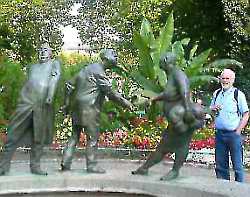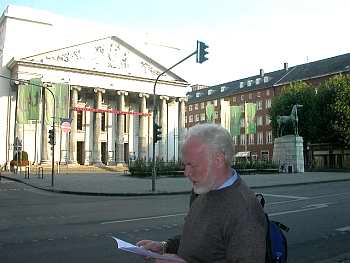

Aachen
 We followed
our noses to the gingerbread shops . . .
We followed
our noses to the gingerbread shops . . .
 but they all said
they do not have gingerbread. When I pointed at cookies that
certainly looked and smelled like gingerbread, they said they
were "Printen". Rolf speaks fluent German but he has
not heard the word "Printen" before. Frustrated, we
rested at an outdoor café across a yellow brick building that
fascinated me. Many buildings had red or brown brick bu this had
yellow . While Rolf enjoyed his coffee and brandy, I looked at
the tourism brochure and it said right there that gingerbread is
an Aachen specialty for which the city is rightly famous. So, I
figured that Printen must be gingerbread because all the pastry
shops had rows of shelves with Printen on open trays and gift-wrapped
boxes in pine wood, bright tin, and enamel that all said "Aachen
Printen". We hurried back to the bakeshop, pausing briefly
at interesting landmarks like the sculptures of the "Bakhauv",
"Chicken Thief" and the "Marionettes Fountain".
but they all said
they do not have gingerbread. When I pointed at cookies that
certainly looked and smelled like gingerbread, they said they
were "Printen". Rolf speaks fluent German but he has
not heard the word "Printen" before. Frustrated, we
rested at an outdoor café across a yellow brick building that
fascinated me. Many buildings had red or brown brick bu this had
yellow . While Rolf enjoyed his coffee and brandy, I looked at
the tourism brochure and it said right there that gingerbread is
an Aachen specialty for which the city is rightly famous. So, I
figured that Printen must be gingerbread because all the pastry
shops had rows of shelves with Printen on open trays and gift-wrapped
boxes in pine wood, bright tin, and enamel that all said "Aachen
Printen". We hurried back to the bakeshop, pausing briefly
at interesting landmarks like the sculptures of the "Bakhauv",
"Chicken Thief" and the "Marionettes Fountain".




Aachen
is a small town in North Rhine-Westphalia in western Germany.
Also known as Aix la
Chapelle, Aachen retains some of relics of
the time when it was a Roman camp, as in the remains of a Roman
porticus right in the middle of a small busy square. Thermal
springs that reach temperatures up to 74°C abound in Aachen
and attracted first the Celts, then the Romans, to settle in the
area nown known as Aachen. In 768 AD, Charlemagne inherited his
father's kingdom and built a palatinate that became his permanent
residence. It is said that Charlemagne loved to swim and he would
often invite his sons and his court to join him at the thermal
springs.
 Elisenbrunnen
marks the location of an old Roman bath and the Tourism Office is
located to the right of the building (see inset). In the main
hall are two fountains with continuously pouring sulphuric water
that is pleasantly warm but smells rather of rotten eggs, filling
the round hall with its odor. On one wall hangs a plaque
recording all the royal and famous personages who bathed at
Elisenbrunnen.
Elisenbrunnen
marks the location of an old Roman bath and the Tourism Office is
located to the right of the building (see inset). In the main
hall are two fountains with continuously pouring sulphuric water
that is pleasantly warm but smells rather of rotten eggs, filling
the round hall with its odor. On one wall hangs a plaque
recording all the royal and famous personages who bathed at
Elisenbrunnen.
Rolf
was delighted with the water and filled his flask with it, after
splashing his face and arms. Me.... I refused to wash my hands in
it or take even a small sip even if I was thirsty with the
gingerbread I had been munchin. Never mind if Charlemagne loved
those thermal springs, I prefer the Pansol and Los Bańos hot
springs. For two days Rolf sipped water from that flask but threw
it out the day "the water had lost its nice smell".

It
was not easy to find the entrance to the church because the door
opens into a side street and there were renovations being on the
exterior at the time of our visit.
Charlemagne
was buried beneath the west door of the cathedral on the same day
he died, January 28, 814. The Cathedral has an octagonal
structure, each side of which is 18 ft and 48 ft high up to the
top wall, plus 12 ft more up to the roof. Charlemagne's throne
was said to be in the west wing of he main hall, with a direct
view of the altar of the Saviour at the east side.

The
Cathedral is magnificent, with its huge marble columns.
Corinthian capitals and the mosaic at the Dome showing the "24
Elders of the Revelation" and the opper and guilt candelabra
that was a gift of Frederick II in 1215. Standing at the throne
room of Charlemagne made me feel that I had stepped centuries
back in time, but I could not stay long inside the church because
I kept remembering the hundreds of thousands who had died in
"in the name of Christianity" In a small chapel in the
cathedral was a small altar with an interesting crucifix, and
outside the chapel was a baptistry with a replica of a skull
whose symbolism I did not care to interpret.



The
Aachen Rathaus (town hall) looks like an old castle, and ideed
itwas, once upon a time. But it was getting late and it was time
to start looking for Hauptbahnhof because Orhan drove us to
Aachen from Brauweiler and we did not know where to get the train
back to Köln.
On
our way way to the Hauptbahnhof, we passed by a street violinist
who was playing some classical music that sounded quite
melancholy. There was also the "Money Fountain" that
captured the changing values of contemporary society,
particularly in terms of material wealth.




Aachen's
theater is big and modern but with a classic facade, in the same
way that the city's Hauptbahnhof was a modern affair with a
facade that reveals the rich and ancient heritage of the city.

One day
in a city that was once the center of a great empire would always
be memorable for me, but it is Aachen's "printen brot"
that would make me go back to Aachen again and again.... just as
I now sing "All I want for Christmas is a Printen Brot
..."

HOME |